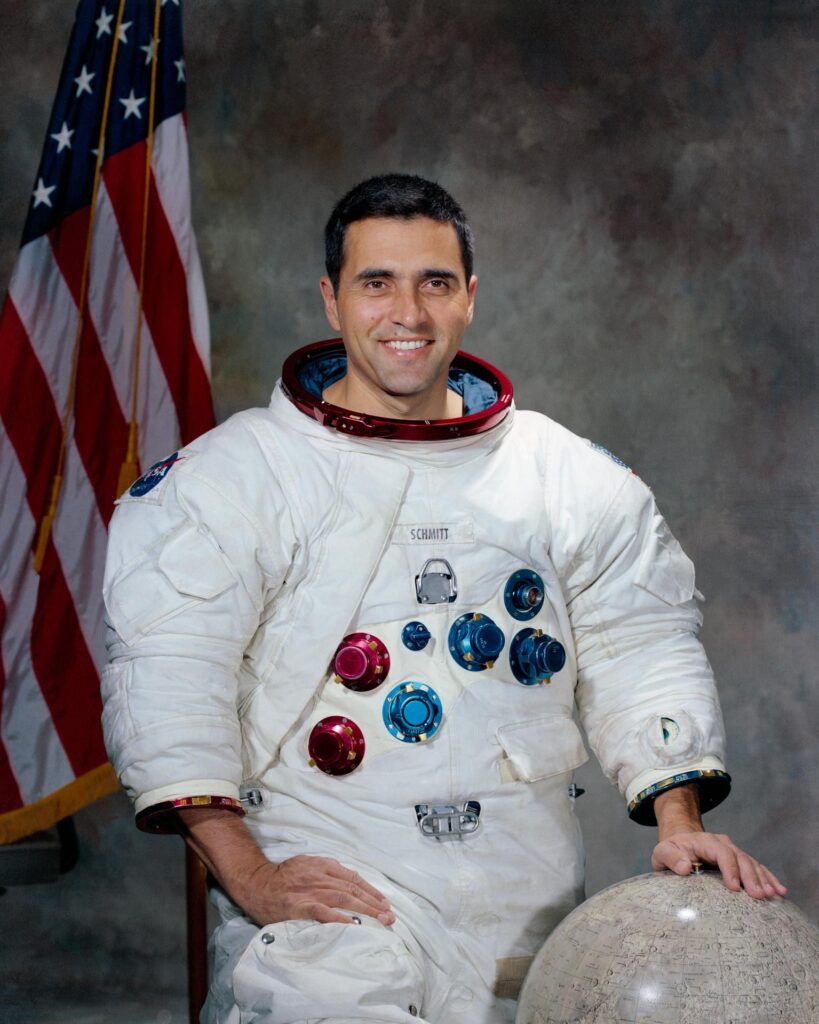Apollo 17 astronaut and the only scientist to walk on the Moon.
The Lunar Module pilot on Apollo 17, the final manned lunar landing mission, Harrison H. Schmitt, a geologist, and native New Mexican, is the only scientist to have explored the Moon’s surface.
Schmitt was born July 3, 1935, in Santa Rita, New Mexico. A graduate of Western High School in Silver City, New Mexico, he received a Bachelor of Science degree in Science from the California Institute of Technology in 1957, and a Doctorate of Philosophy in Geology from Harvard University in 1964.
In 1957, Schmitt conducted research for the Norwegian Geological Survey on the west coast of Norway and then worked for the U.S. Geological Survey in New Mexico and Montana. In 1961, he was a teaching fellow at Harvard, then spent two summers as a geologist in Alaska. Schmitt was involved in photo and telescopic mapping of the Moon with the U.S. Geological Survey’s Astro-geology Center at Flagstaff, Arizona, when NASA selected him in June 1965 in its first group of scientist-astronauts.
Because he was not a pilot, as all previous astronauts were, Dr. Schmitt attended a 53-week course in flight training at Williams Air Force Base, Arizona, receiving his Air Force jet pilot wings and later his Navy helicopter wings. While he trained for a lunar mission, Schmitt provided Apollo flight crews with detailed instruction in lunar navigation, geology and feature recognition. He assisted in the integration of scientific activities into Apollo missions and participated in geologic, petrographic, and stratigraphic analyses of samples returned from the Moon by Apollo missions. He has logged more than 2,100 hours flying time, including 1,600 hours in jet aircraft.
Harrison Schmitt was backup Lunar Module pilot for Apollo 15 and was to be on the Apollo 18 crew, but when that flight was canceled, he was moved up to Apollo 17 so that a trained geologist could travel to the moon on the final Apollo journey. Apollo 17 blasted off during the night of December 7, 1972, and three days later Schmitt and Commander Gene Cernan landed on the moon in the Lunar Module Challenger in a mountain-ringed valley named Taurus-Littrow, while Ron Evans orbited overhead in the Command Module America. “It’s a good geologist’s paradise if I’ve ever seen one!” Schmitt exclaimed as he followed Cernan to the surface for the first of three lunar rover excursions during their three-day stay. Schmitt’s spirits were so high he even sang “I was strolling on the Moon one day” during one of his EVAs.
This last Apollo mission to the Moon for the United States broke several records, including longest manned lunar landing flight (301 hours, 51 minutes); longest lunar surface extravehicular activities (22 hours, 4 minutes); largest lunar sample return (an estimated 249 pounds); and longest time in lunar orbit (147 hours, 48 minutes). Before blasting off for a rendezvous with Evans in America, Cernan and Schmitt left a plaque on the Moon with the following inscription: “Here man completed his first exploration of the Moon, December 1972 A.D. May the spirit of peace in which we came to be reflected in the lives of all mankind.”
Apollo 17 ended safely with a splashdown in the Pacific Ocean less than half a mile from the target point on December 19, as the historic lunar landing program came to an end. Dr. Schmitt logged 301 hours and 51 minutes in space, including 22 hours and 4 minutes spent in extravehicular activity on the lunar surface.
In July of 1973, Harrison Schmitt became one of the first Sherman Fairchild Distinguished Scholars at the California Institute of Technology. His appointment was extended to run through July 1975, concurrent with his other activities in NASA. In February 1974, Schmitt assumed additional duties as the agency’s Chief of Scientist-Astronauts.
Dr. Schmitt was appointed NASA’s Assistant Administrator for Energy Programs in May 1974, responsible for coordinating NASA support to other Federal Agencies conducting energy research and development and for managing NASA programs applying aeronautics and space technology to the generation, transmission, storage, conservation, utilization and management of energy for terrestrial applications.
In August of 1975, Harrison Schmitt resigned his post with NASA to run for the United States Senate as a Republican in his home state of New Mexico. He was elected on November 2, 1976, and in January 1977, began a single six-year term as a New Mexico Senator in Washington, D.C. His major committee assignments were on the Commerce, Science and Transportation Committee; the Banking, Housing and Urban Affairs Committee and the Select Committee on Ethics. He was the ranking Republican member of the Ethics Committee; of the Science, Technology, and Space Subcommittee of Commerce, and the Consumer Sub-committee of Banking.
From 1982 to 1994, Schmitt worked as a consultant, corporate director, and free-lance writer and speaker on matters related to space, science, technology, and public policy. In 1994, he was appointed as an Adjunct Professor of Engineering at the University of Wisconsin and Chairman and President of the Annapolis Center for Environmental Quality. He currently resides in Albuquerque, New Mexico. Asteroid 7749 Jackschmitt is named in his honor.
In his career Dr. Schmitt has won many honors, including the Johnson Space Center Superior Achievement Award (1970); NASA’s Distinguished Service Medal (1973); the Arthur S. Fleming Award (1973); Engineer of the Year Award, National Society of Professional Engineers, Legislative Recognition Award (1981); the National Security Award, highest Civil Defense Award (1981); the NASA Distinguished Public Service Medal (1982); the Lovelace Award, Society of NASA Flight Surgeons (1989); the G. K. Gilbert Award, Planetary Geology Division, Geological Society of America (1989); and the Award for Excellence, Presbyterian Healthcare Foundation (1990).

